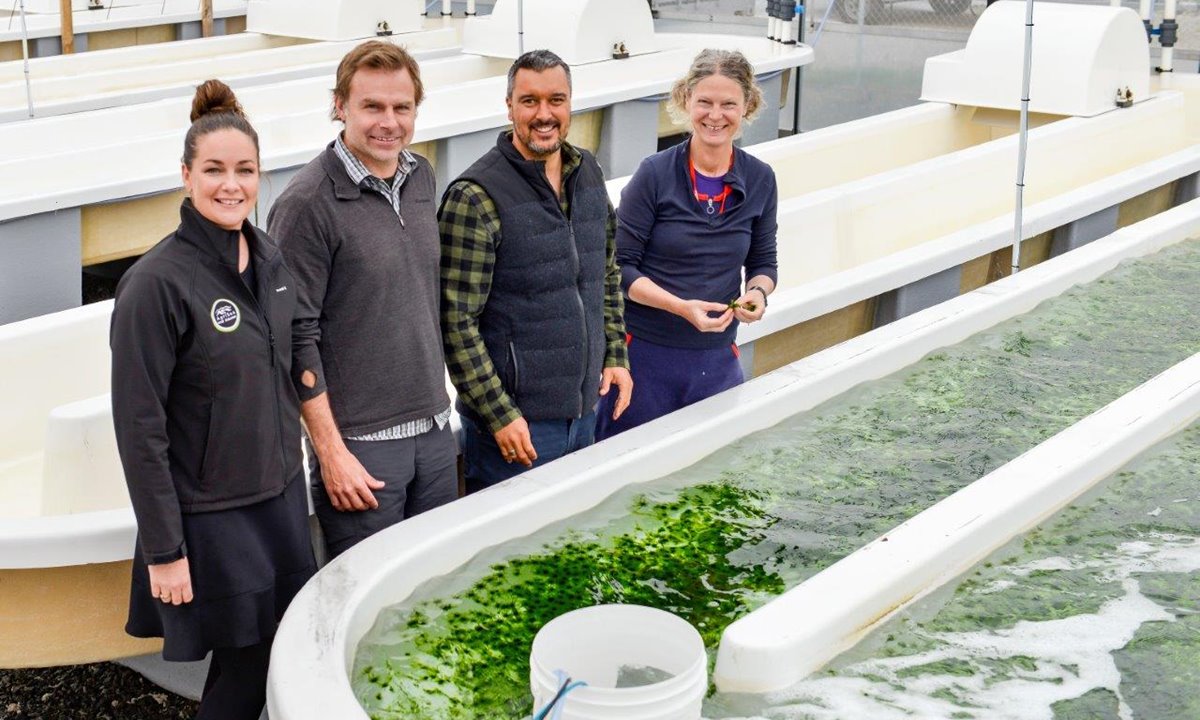A nationwide first land-based seaweed trial aiming to clean up our waterways is about to get growing beside the Firth of Thames in the Hauraki Gulf.
Paeroa seaweed innovation company AgriSea is working with University of Waikato on a two-year sea lettuce (Ulva) growing trial at Kopu marine precinct in the Coromandel.
Backed by the Ministry for Primary Industries’ Sustainable Food and Fibre Futures fund, seaweed will grow for 12 months in three tanks drawing water from the Waihou Estuary, with data collation and analysis the final year.
The seaweed can be turned into high-value products while the process of growing it has a multitude of benefits.
AgriSea Managing Director Tane Bradley says seaweed doesn’t have root systems and so grows by pulling nutrients from the water around it.
“In this case, as Ulva grows it pulls Nitrogen from the water and incorporates it into its tissue.”
Known as ‘bioremediation’, the project will use of seaweed in an attempt to clean excess nutrients from the Waihou Estuary.
“The seaweed in tanks will act as a sponge and filter feed on excess minerals like Nitrogen, Phosphorous and other heavy metals – in short cleaning up the water, which is then returned to the sea, filtered and clean.”
The two-year project is a collective effort, with University of Waikato Environmental research fellow Marie Magnusson leading the research team.
The locally present species of Ulva will be cultivated at the University of Waikato’s aquaculture facility where researchers will use DNA barcoding to confirm its genetic identity.
The bulk of the investment of $697,000 is from the Ministry for Primary Industries’ Sustainable Food and Fibre Futures fund, with $108,000 from AgriSea and $150,000 from the Agricultural and Marketing Research and Development Trust (AGMARDT). Thames-Coromandel District Council is gifting the land lease for the project, with support from Ngati Maru and Ngati Hako. Hauraki District Council, Waikato regional council and Te Waka are also supporting this project.
“Local Iwi are heavily invested in the health and wellbeing of our waterways and if this pilot proves successful, will look to upscale the on-land bioremedial systems in the Hauraki area,” Bradley
AgriSea is partnered with Farm Source already helping farmers improve soil and water quality using AgriSea’s seaweed bio stimulants as an alternative to chemical fertilisers.
Bio stimulants made from seaweed are high-value macro-algal products used on dairy, sheep and beef farms as well as in the apiculture, horticulture and viticulture industries.
“Currently the loss of nutrients not absorbed by plants enters the soil and drains into groundwater that leads straight to our waterways. This promotes algal blooms which reduces oxygen levels, which then threatens animals such as tuna (eels), kākahi (freshwater mussels), kōura (freshwater crayfish), and īnanga (whitebait),” Damien O’Connor said.
“The aim is to clean up and revitalise our waterways with New Zealand seaweed as they key, and to create jobs in the science sector and build on the work by farmers who are already working to improve their farming systems to reduce environmental pressure.
The production of seaweed on land is new for New Zealand.
It is estimated that up to 50 tonnes of dry Ulva per hectare could be produced from a scaled-up facility, providing the biomass for added value products.
"There’s a growing desire from science institutes with assistance from Government funding agencies to explore innovative projects such as this, not only for their environmental benefits but as potential commercial harvest of seaweed for food, bio stimulants and high value bio actives.”
Bradley says the Ulva species has about 20 per cent protein which is one of the higher percentages for seaweed.
Damien O’Connor said the aims of this proof-of-concept research support many of the goals set out in Fit for a Better World, the Government’s 10-year food and fibre sector roadmap aimed at lifting productivity, sustainability and creating jobs to drive New Zealand’s economic recovery from COVID-19.
“This project supports sustainability, which is also in line with the Government’s Aquaculture Strategy. Seaweeds are being increasingly recognised for their potential.
“If successful, this will be an environmentally-friendly way to improve water quality, create jobs in the science sector, revitalise our waterways and improve our on-land farming systems,” Damien O’Connor said.
“AgriSea estimates the potential value as up to $219,000 per hectare of production per annum[TG(1] ,” says Bradley “This is based on nitrogen credits coming into effect in New Zealand and the value of Ulva based products which are on AgriSea’s Innovation pipeline.
While New Zealand doesn’t have a nitrogen trading scheme yet, if one was introduced the biomass produced in one year from one hectare of ponds would be worth NZ$82,000 in nitrogen credits, based on international values for nitrogen trading.



.jpg?sfvrsn=14164ce5_1&mode=crop&width=770&height=462&format=jpeg&quality=85)
.jpg?sfvrsn=414c0434_1&mode=crop&width=770&height=462&format=jpeg&quality=85)
.png?sfvrsn=16db4cf2_1&mode=crop&width=770&height=462&format=jpeg&quality=85)